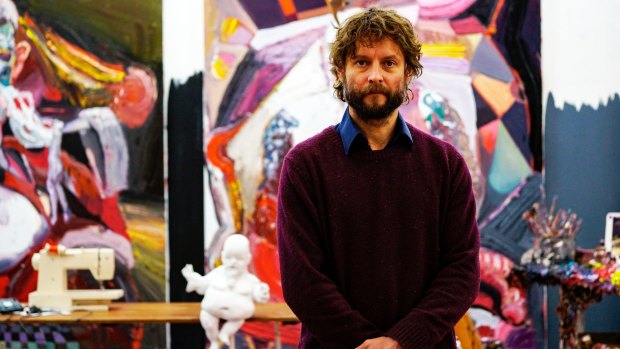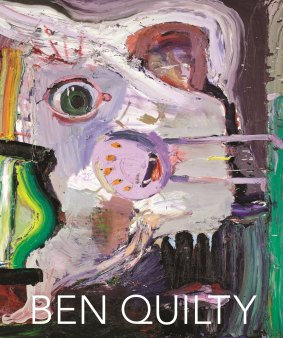By Andrew Stephens
ART
Ben Quilty
Ben Quilty
Lantern (Penguin Books), $90
Cook After Baghdad (2012) is a large bronze sculpture Ben Quilty cast shortly after returning from Afghanistan, where he was 2011's Australian Official War Artist. To the same scale as Baghdad's famously toppled Saddam Hussein sculpture, the huge, hollow bust is pictured in the book Ben Quilty lying on its cheek amid a green, manicured garden. Plants spill from its tattered neck.

Artist Ben Quilty at his studio in Mittagong. Credit: Olivia Ralph
The critique is plain, visually conveyed, just as it is on the following page in the painting Cook Rorschach (2009). Quilty's Rorschach works are made when a thickly covered, wet painting is pressed up against another blank canvas, producing mirrored images. In this instance, that famous British explorer's face has spawned a murky, blurred doppelganger. As with the Cook sculpture, words are hardly needed: strategically, this comprehensive and handsomely produced book comes with but a scattering of brief essays.
Published to accompany Quilty's large-scale mid-career retrospective, which opened in Adelaide this month (later travelling to Queensland Art Gallery and the Art Gallery of New South Wales), its abundance of reproductions and studio shots convey Quilty's deeply physical painting method, and his persistent concerns with masculinity, violence, injustice, history and sheer life-energy.

The paintings remain the stars of Ben Quilty's sumptuous book.
The Art Gallery of South Australia's Lisa Slade, curator of the retrospective, observes early in the book that the colour purple – lilac, mauve, lavender, plum and so on – has for thousands of years been tinted with sorrow and destruction. Even "imperial purple", favoured in antiquity by the powerful, was described as "the tears of the sea snail": producing a tiny quantity of the dye involved killing thousands of murex shellfish. And purple, Slade tells us, is Quilty's favourite colour, his particular shade like "a bruise two days in", both "brutal and beautiful". Her evocative writing style gently conjures gauzy images – but ones that are all her own, a distinct challenge in a book whose 352 pages are dominated by Quilty's powerful work.
Of course, nothing compares to standing before a Quilty painting in the flesh, as it were – the enormously thick wedges of paint he applies to the canvas tend to elicit a bodily response from viewers. Novelist Richard Flanagan, a friend of Quilty's who travelled with him to Europe and the Middle East in 2016 to document the refugee crisis, takes up this question in his foreword. Discussing High Tide Mark (2016), a painting of a yellow life jacket done as a result of the trip, he describes the jacket floating in space like a balloon, its dangling ties suggesting it is "tethered to some greater unseen reality" below.
"Absent from the picture – as they are absent from the reportage of their crisis, as they are absent from our society – is the refugee who wore the life jacket, a subject unable to even be a subject." The book's reproduction "does no justice to the sheer intensity of Quilty's painting," he writes. Thus, as we are fascinated by the accompanying image but yearn to see the real thing, Flanagan evokes gracefully both the essential contradiction of books that reproduce paintings – and expresses the binary of Quilty's art, where great beauty often sits amid a nightmare.
Flanagan isn't the first to observe Quilty's paintings being "more sculpted than painted" with "thick, wild, angry forms" and a "rush of emotion". These qualities arise in the Rorschach paintings, and curator Slade discusses several that deal with first European contact with Australian Indigenous people, where "the trauma of contact is rendered through the visceral contact of one canvas on another". Observing Fairy Bower Rorschach (2012), concerned with a reputed 1834 massacre of Indigenous women and children, she writes that by engaging with Australia's most nationalising and colonising genre – that of landscape – Quilty transforms the genre.
For all these intriguing observations – and more from artist Vincent Namatjira, Indigenous leader Frank Young and curator Justin Paton – the paintings remain the stars of this sumptuous book. For many who buy Ben Quilty at the exhibition's inevitable gift shop, it will be a powerful echo of what they have just seen. As Slade ventures with Fairy Bower Rorschach, Quilty's work "threatens to envelop us". That is a marvellous thing.